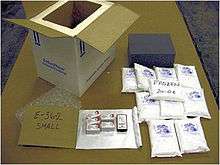Insulated shipping container
Insulated shipping containers are a type of packaging used to ship temperature sensitive products such as foods, pharmaceuticals, and chemicals. They are used as part of a cold chain to help maintain product freshness and efficacy. The term can also refer to insulated intermodal containers or insulated swap bodies.
Construction

An insulated shipping container might be constructed of:
- a vacuum flask, similar to a "thermos" bottle
- fabricated thermal blankets or liners
- molded expanded polystyrene foam (EPS, styrofoam), similar to a cooler
- other molded foams such as polyurethane, polyethylene
- sheets of foamed plastics
- reflective materials: (metallised film)
- bubble wrap or other gas filled panels
- other packaging materials and structures
Some are designed for single use while others are returnable for reuse. Some insulated containers are decommissioned refrigeration units. Some empty containers are sent to the shipper disassembled or “knocked down”, assembled and used, then knocked down again for easier return shipment.
Use

Insulated shipping containers are part of a comprehensive cold chain which controls and documents the temperature of a product through its entire distribution cycle. The containers may be used with a refrigerant or coolant such as:[1]
- block or cube ice, slurry ice
- dry ice
- Gel or ice packs (often formulated for specific temperature ranges)
- Some products (such as frozen meat) have sufficient thermal mass to contribute to the temperature control
A digital Temperature data logger or a time temperature indicator is often enclosed to monitor the temperature inside the container for its entire shipment.
Labels and appropriate documentation (internal and external) are usually required.
Personnel throughout the cold chain need to be aware of the special handling and documentation required for some controlled shipments. With some regulated products, complete documentation is required.
Design and Evaluation
The use of “off the shelf” insulated shipping containers does not necessarily guarantee proper performance. Several factors need to be considered:[2]
- the sensitivity of the product to temperatures (high and low) and to time at temperatures
- the specific distribution system being used: the expected (and worst case) time and temperatures
- regulatory requirements
- the specific combination of packaging components and materials being used
In specifying an insulated shipping container, the two primary characteristics of the material will be the insulation properties of the matieral known as the "K Value" and the thickness of the material. These two attributies determine that majority of the functionality of the component. One should attempt to control the latent heat of any insultated shipping container when is use, as this will affect the overall performance of the component when integrated into a system (closed system with refrigerant & product).
It is wise (and sometimes mandatory) to have formal verification of the performance of the insulated shipping container. Laboratory package testing might include ASTM D3103-07, Standard Test Method for Thermal Insulation Performance of Packages, ISTA Guide 5B: Focused Simulation Guide for Thermal Performance Testing of Temperature Controlled Transport Packaging, and others.[3] In addition, validation of field performance is extremely useful.
Specialists in design and testing of packaging for temperature sensitive products are often needed. These may be consultants, independent laboratories, universities, or reputable vendors.
See also
References
- ↑ Matsunaga, K; Burgess, Lockhart (March 2007). "Two methods for calculating the amount of refrigerant required for cyclic temperature testing of insulated packages". Packaging Technology and Science. 20 (2): 113–123. doi:10.1002/pts.747.
- ↑ Choi, Seung-Jin; Burgess (November 2007). "Practical mathematical model to predict the performance of insulating packages". Packaging Technology and Science. 20 (6): 369–380. doi:10.1002/pts.762.
- ↑ Singh, S. P.; Burgess, Singh (January 2008). "Performance comparison of thermal insulated packaging boxes, bags and refrigerants for single-parcel shipments". Packaging Technology and Science. 21 (1): 25–35. doi:10.1002/pts.773.
External links and resources
- "Cold Chain Management", 2003, 2006,
- Brody, A. L., and Marsh, K, S., "Encyclopedia of Packaging Technology", John Wiley & Sons, 1997, ISBN 0-471-06397-5
- Lockhart, H., and Paine, F.A., "Packaging of Pharmaceuticals and Healthcare Products", 2006, Blackie, ISBN 0-7514-0167-6